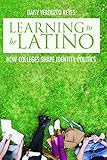Learning to Be Latino : How Colleges Shape Identity Politics / Daisy Verduzco Reyes.
Material type: TextSeries: Critical Issues in American EducationPublisher: New Brunswick, NJ : Rutgers University Press, [2018]Copyright date: ©2018Description: 1 online resource (212 p.) : 2 figures 8 tablesContent type:
TextSeries: Critical Issues in American EducationPublisher: New Brunswick, NJ : Rutgers University Press, [2018]Copyright date: ©2018Description: 1 online resource (212 p.) : 2 figures 8 tablesContent type: - 9780813596471
- 9780813596501
- 371.829/68073 23
- LC2670.6 .R49 2018
- online - DeGruyter
- Issued also in print.
| Item type | Current library | Call number | URL | Status | Notes | Barcode | |
|---|---|---|---|---|---|---|---|
 eBook
eBook
|
Biblioteca "Angelicum" Pont. Univ. S.Tommaso d'Aquino Nuvola online | online - DeGruyter (Browse shelf(Opens below)) | Online access | Not for loan (Accesso limitato) | Accesso per gli utenti autorizzati / Access for authorized users | (dgr)9780813596501 |
Browsing Biblioteca "Angelicum" Pont. Univ. S.Tommaso d'Aquino shelves, Shelving location: Nuvola online Close shelf browser (Hides shelf browser)

|

|

|

|

|

|

|
||
| online - DeGruyter Adventures in Shondaland : Identity Politics and the Power of Representation / | online - DeGruyter L.A. Private Eyes / | online - DeGruyter Milking in the Shadows : Migrants and Mobility in America's Dairyland / | online - DeGruyter Learning to Be Latino : How Colleges Shape Identity Politics / | online - DeGruyter Phonographic Memories : Popular Music and the Contemporary Caribbean Novel / | online - DeGruyter The Patagonian Sublime : The Green Economy and Post-Neoliberal Politics / | online - DeGruyter Leading for Tomorrow : A Primer for Succeeding in Higher Education Leadership / |
Frontmatter -- Contents -- Preface -- Higher Education and Latino Students -- Part 1. University Institutional Contexts -- Part 2. Student Interactions and Meaning-Making -- Methodological Appendix: Studying Student Organizations in Multiple Institutions -- Acknowledgments -- Notes -- References -- Index -- About the author
restricted access online access with authorization star
http://purl.org/coar/access_right/c_16ec
In Learning to Be Latino, sociologist Daisy Verduzco Reyes paints a vivid picture of Latino student life at a liberal arts college, a research university, and a regional public university, outlining students' interactions with one another, with non-Latino peers, and with faculty, administrators, and the outside community. Reyes identifies the normative institutional arrangements that shape the social relationships relevant to Latino students' lives, including school size, the demographic profile of the student body, residential arrangements, the relationship between students and administrators, and how well diversity programs integrate students through cultural centers and retention centers. Together these characteristics create an environment for Latino students that influences how they interact, identify, and come to understand their place on campus. Drawing on extensive ethnographic observations, Reyes shows how college campuses shape much more than students' academic and occupational trajectories; they mold students' ideas about inequality and opportunity in America, their identities, and even how they intend to practice politics.
Issued also in print.
Mode of access: Internet via World Wide Web.
In English.
Description based on online resource; title from PDF title page (publisher's Web site, viewed 30. Aug 2021)


